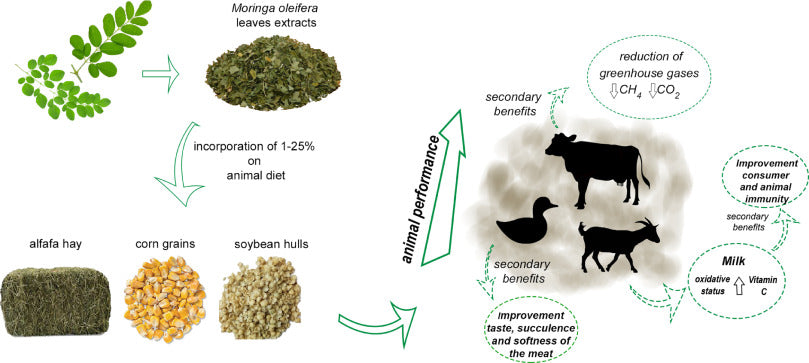In the intricate dance of nature and human survival, finding a balance between meeting human needs and preserving biodiversity is crucial. Moringa Oleifera, known as the "Miracle Tree," emerges as a symbol of this balance. Its cultivation and use present a unique opportunity to support both human health and wildlife conservation. This article delves into the sustainable integration of Moringa into our lives, highlighting its potential to contribute to biodiversity preservation while addressing nutritional deficiencies.
Moringa: A Nutritional Powerhouse Supporting Human and Environmental Health
Moringa cultivation offers a dual benefit that cannot be overlooked. Firstly, its rich nutrient profile, including essential vitamins, minerals, and proteins, stands as a potent solution to malnutrition and food insecurity, particularly in vulnerable communities. Thus, it provides nutritional security in an unparalleled way.
Secondly, Moringa's drought-resistant nature and ability to grow in degraded soils make it an ideal crop for reforestation projects and habitat restoration, contributing significantly to environmental sustainability. Moringa plantations can also enhance ecosystems in a variety of ways, such as strategically planting Moringa in biodiversity hotspots to aid in the restoration of ecosystems, providing food and habitat for a variety of species, from pollinators to birds and small mammals. Furthermore, Moringa helps in soil stabilization and water conservation, improving the health of the surrounding environment and supporting the broader ecosystem.
All these benefits make Moringa cultivation an excellent option for anyone looking to contribute to environmental sustainability and provide nutritional security for vulnerable communities.
Balancing Human Needs with Wildlife Conservation
Sustainable Harvesting Practices
Moringa is a valuable plant that has a wide range of uses, including as a food source, medicine, and as a raw material for various products. However, the increasing demand for Moringa has led to unsustainable harvesting practices that threaten the natural habitats and wildlife. To address this challenge, sustainable harvesting practices are needed that support the conservation of natural resources.
Community-based Management
One approach to achieving sustainable Moringa cultivation and harvesting is through community-based management. This approach involves working with local communities to develop strategies that support sustainable Moringa cultivation, harvesting, and processing. By involving local people in the management of Moringa resources, it ensures that the practices do not encroach on natural habitats or harm wildlife. It also promotes community ownership of the Moringa resources, which helps to ensure their long-term sustainability.
Agroforestry Systems
Another approach to promoting sustainable Moringa cultivation is through the integration of Moringa into agroforestry systems. Agroforestry systems involve the cultivation of trees, crops, and livestock in a way that promotes a harmonious coexistence with nature. By integrating Moringa into agroforestry systems, it preserves forest cover and wildlife corridors while providing valuable resources for human use. This approach also promotes soil health, which helps to improve the productivity of the Moringa crops.
Ethical Sourcing and Biodiversity Protection
The increasing demand for Moringa has led to the exploitation of natural resources and the exploitation of vulnerable communities. To address this challenge, ethical sourcing practices are needed that support local communities and prevent the exploitation of natural resources.
Fair Trade and Ethical Sourcing
One way to promote ethical sourcing of Moringa is through the adoption of fair trade practices in the supply chain. Fair trade practices ensure that the local communities receive a fair price for their products and services. It also promotes sustainable Moringa cultivation practices that are environmentally friendly and socially responsible.
Conservation Partnerships
Another approach to promoting ethical sourcing of Moringa is through conservation partnerships. This approach involves collaborating with conservation organizations to develop guidelines for Moringa cultivation that protect endangered species and critical habitats. The guidelines also promote sustainable harvesting practices that do not encroach on natural habitats or harm wildlife. By working with conservation organizations, it ensures that the Moringa resources are managed sustainably and that the local communities benefit from the resources.
Moringa and Wildlife Conservation: Industry Initiatives for Sustainable Development
Corporate Responsibility in Moringa Production
- Sustainability Certifications: In order to demonstrate their commitment to environmentally friendly practices and wildlife conservation, more and more companies involved in Moringa production are seeking sustainability certifications. These certifications ensure that the production process is sustainable and has minimal impact on the environment.
- Research and Development: Investing in research is crucial to explore low-impact cultivation techniques and to understand the ecological benefits of Moringa. Research can help identify ways to cultivate Moringa in a way that aligns with conservation goals, ensuring that the production process is sustainable and has minimal impact on the environment.
Community Engagement and Education
- Empowering Local Communities: Educating and empowering local communities to cultivate Moringa sustainably is essential to improve livelihoods and ensure stronger conservation outcomes. Local communities can learn how to cultivate Moringa in a way that ensures environmental sustainability, leading to better yields and a better income for farmers.
- Awareness Campaigns: Launching awareness campaigns about the importance of biodiversity and how sustainable Moringa cultivation can contribute to wildlife conservation is key to building a sustainable future. These campaigns can help educate consumers and businesses about the importance of Moringa and how it can be produced in a way that benefits both people and the environment.
The Future of Moringa in Balancing Human and Environmental Well-being
Innovations in Sustainable Agriculture
The cultivation of Moringa has gained significant attention in recent years due to its nutritional properties, adaptability to different climates, and potential as a sustainable source of food and feed. However, the sustainability of Moringa cultivation is threatened by several challenges, including climate change, soil erosion, water scarcity, and pests and diseases. To address these challenges, researchers and practitioners are exploring various approaches to improve the efficiency, productivity, and environmental performance of Moringa plantations.
One promising approach is to leverage technological advancements to monitor and manage Moringa plantations more effectively and sustainably. For instance, precision agriculture techniques such as soil sensors, drones, and GPS can help farmers optimize the use of water, nutrients, and pesticides, reduce waste and pollution, and increase yields and quality. Likewise, remote sensing technologies such as satellite imagery, LiDAR, and hyperspectral sensors can provide valuable information on the status and dynamics of Moringa plantations, such as biomass, chlorophyll content, water stress, and pest infestation. Moreover, big data analytics can process and analyze large amounts of data from multiple sources to generate insights and recommendations for farmers, policymakers, and researchers.
Another approach to enhance the sustainability of Moringa cultivation is to adopt permaculture practices that mimic natural ecosystems and promote biodiversity. Permaculture is a holistic approach to agriculture that emphasizes the integration of plants, animals, and microorganisms in a diverse and resilient system. By mimicking natural ecosystems, permaculture practices can enhance soil health, water retention, carbon sequestration, and nutrient cycling, while reducing the need for external inputs and minimizing environmental impact. Some examples of permaculture practices that can be applied to Moringa cultivation include agroforestry, intercropping, cover cropping, composting, and biological pest control.
By combining technological advancements and permaculture practices, Moringa growers and stakeholders can achieve a more sustainable and resilient system that balances productivity, profitability, and environmental stewardship. However, the adoption and scaling up of these approaches require adequate knowledge, skills, and resources, as well as supportive policies and institutions. Therefore, further research, development, and dissemination of best practices are needed to accelerate the transition towards a sustainable and equitable Moringa industry.
Global Collaboration for Conservation
International Partnerships: Building global partnerships to share knowledge, resources, and best practices for integrating Moringa cultivation into conservation strategies.
Policy Advocacy: Advocating for policies that support sustainable agriculture, nutritional security, and biodiversity conservation, with Moringa as a key component.
Conclusion:
Moringa Oleifera stands at the crossroads of human nutrition and environmental conservation, offering a sustainable pathway to address some of the most pressing challenges of our time. By embracing sustainable cultivation practices, ethical sourcing, and community engagement, we can harness the power of Moringa to nourish people and protect our planet's precious wildlife. As we move forward, the continued integration of Moringa into conservation and development efforts will be vital in crafting a future where human needs and biodiversity preservation go hand in hand, fostering a healthier, more sustainable world for generations to come.

